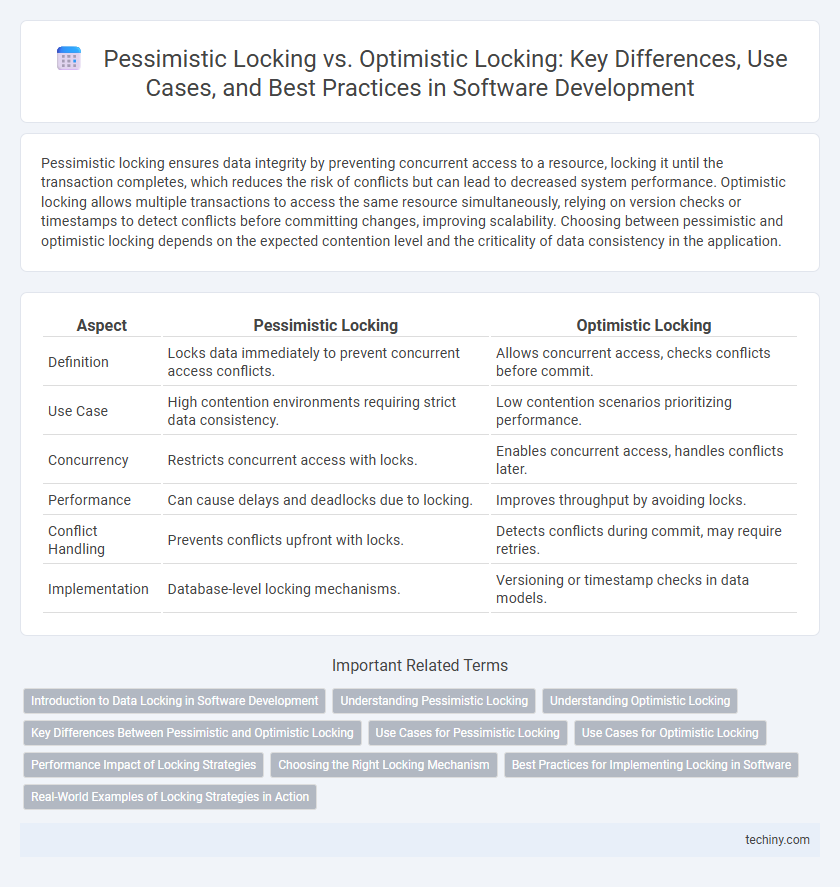Pessimistic locking ensures data integrity by preventing concurrent access to a resource, locking it until the transaction completes, which reduces the risk of conflicts but can lead to decreased system performance. Optimistic locking allows multiple transactions to access the same resource simultaneously, relying on version checks or timestamps to detect conflicts before committing changes, improving scalability. Choosing between pessimistic and optimistic locking depends on the expected contention level and the criticality of data consistency in the application.
Table of Comparison
| Aspect | Pessimistic Locking | Optimistic Locking |
|---|---|---|
| Definition | Locks data immediately to prevent concurrent access conflicts. | Allows concurrent access, checks conflicts before commit. |
| Use Case | High contention environments requiring strict data consistency. | Low contention scenarios prioritizing performance. |
| Concurrency | Restricts concurrent access with locks. | Enables concurrent access, handles conflicts later. |
| Performance | Can cause delays and deadlocks due to locking. | Improves throughput by avoiding locks. |
| Conflict Handling | Prevents conflicts upfront with locks. | Detects conflicts during commit, may require retries. |
| Implementation | Database-level locking mechanisms. | Versioning or timestamp checks in data models. |
Introduction to Data Locking in Software Development
Data locking in software development ensures data integrity by controlling concurrent access to shared resources. Pessimistic locking prevents conflicts through exclusive locks that block other transactions until the current one completes, suitable for high-contention environments. Optimistic locking allows multiple transactions to proceed without immediate locking, relying on validation before commit to detect conflicts, ideal for low-contention scenarios.
Understanding Pessimistic Locking
Pessimistic locking in software development involves locking a resource immediately when a transaction begins to prevent other transactions from accessing it concurrently, ensuring data integrity in high-conflict scenarios. This approach is effective in environments with frequent data contention, as it minimizes the risk of conflicts by serializing access to critical sections or database records. Implementing pessimistic locking can lead to reduced concurrency and potential deadlocks, making it essential to balance locking granularity and transaction duration for optimal performance.
Understanding Optimistic Locking
Optimistic locking in software development allows multiple transactions to proceed without immediate locking, relying on version control or timestamps to detect conflicts at commit time. This concurrency control method is ideal for systems with low conflict rates, enhancing performance by minimizing lock contention and improving throughput. By validating data consistency just before update, optimistic locking reduces the risk of deadlocks and supports scalable, high-availability applications.
Key Differences Between Pessimistic and Optimistic Locking
Pessimistic locking ensures data consistency by locking resources immediately during a transaction to prevent concurrent access conflicts, making it suitable for high-contention environments. Optimistic locking allows multiple transactions to proceed without locking resources upfront, relying on version checks or timestamps to detect conflicts at commit time, ideal for low-contention scenarios. Key differences include conflict detection timing, resource locking strategy, and performance impacts on concurrent data access in software development.
Use Cases for Pessimistic Locking
Pessimistic locking is ideal in environments with high contention for database resources where the likelihood of conflicts is significant, such as banking systems or inventory management. It ensures data integrity by preventing other transactions from modifying the locked data until the current transaction completes, reducing the risk of race conditions and lost updates. This approach is best suited for complex transactions requiring strict consistency and immediate conflict resolution.
Use Cases for Optimistic Locking
Optimistic locking is ideal for applications with low contention and high read-to-write ratios, such as e-commerce platforms and content management systems, where conflicts are infrequent. It allows multiple transactions to proceed without immediate locks, improving concurrency and system throughput. Use cases include scenarios requiring version control for data integrity, like collaborative editing tools and inventory management systems.
Performance Impact of Locking Strategies
Pessimistic locking can significantly reduce concurrency by holding database locks for the duration of a transaction, leading to increased wait times and potential bottlenecks in high-traffic applications. Optimistic locking typically improves performance in environments with low contention by allowing multiple transactions to proceed without immediate locking, checking for conflicts only at commit time. The choice between these strategies depends on the frequency of conflicts and the acceptable latency, with pessimistic locking favoring consistency in concurrent updates and optimistic locking prioritizing throughput in mostly read-heavy workloads.
Choosing the Right Locking Mechanism
Choosing the right locking mechanism in software development depends on data contention and transaction frequency, where pessimistic locking is ideal for high-contention environments to prevent conflicts by locking resources early. Optimistic locking suits scenarios with low contention, reducing overhead by verifying data integrity only at transaction commit. Evaluating application-specific requirements, concurrency levels, and performance impacts ensures selecting the optimal strategy for data consistency and system efficiency.
Best Practices for Implementing Locking in Software
When implementing locking in software development, best practices recommend using pessimistic locking for high-contention environments to avoid conflicts by locking resources early. Optimistic locking suits scenarios with low contention, relying on version checks to ensure data integrity without immediate resource blocking. Combining both approaches with proper transaction management and error handling enhances performance and consistency.
Real-World Examples of Locking Strategies in Action
Pessimistic locking is commonly used in banking systems where data integrity is critical, and concurrent transactions could cause conflicts, such as updating account balances, ensuring one transaction completes before another begins. Optimistic locking is favored in web applications like content management systems, where conflicts are rare and performance benefits by allowing multiple users to edit content simultaneously without heavy locking overhead. Real-world adoption depends on balancing concurrency needs and conflict frequency, with pessimistic locking preventing data corruption and optimistic locking optimizing throughput.
Pessimistic Locking vs Optimistic Locking Infographic

 techiny.com
techiny.com